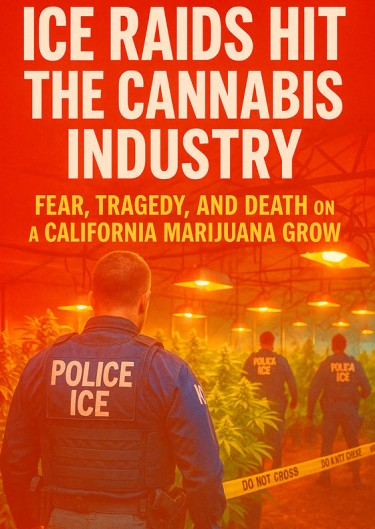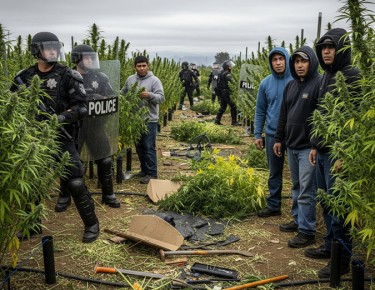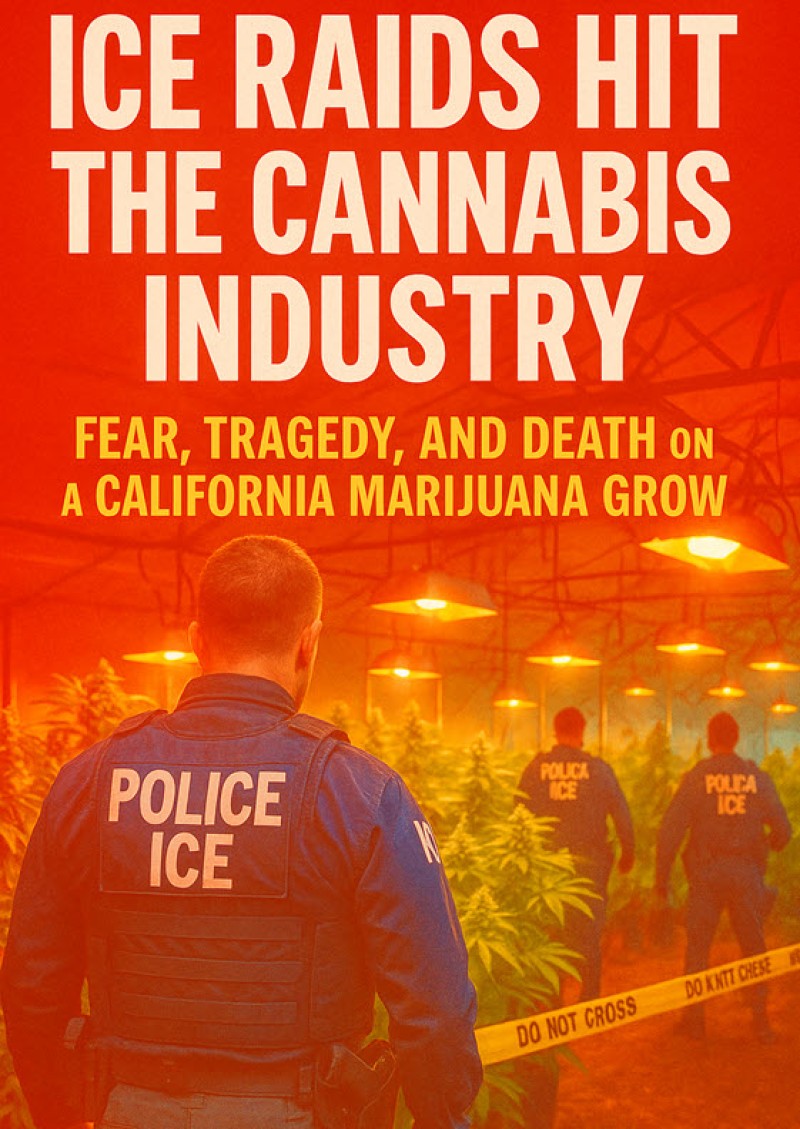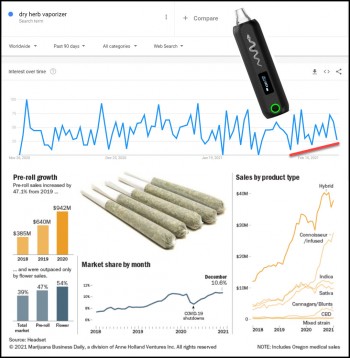
ICE Raids and Gestapo Echoes: Fear, Tragedy, and Trump's Betrayal in California
The ICE raids on two marijuana farms in Carpinteria and Camarillo, California, on July 10, 2025, have ripped open a festering wound in America’s immigration debate, exposing a chilling blend of state violence, corporate collusion, and political betrayal. Federal agents stormed the facilities with military precision, detaining 200 undocumented workers, rounding up minors as young as 14, and leaving one man dead after a desperate attempt to escape. Framed as a mission to rescue children from exploitation, these operations reek of a darker agenda: to terrorize immigrant communities while protecting pharmaceutical giants and surveillance contractors. The tactics—masked agents, military vehicles, and crowd-control measures—cast a shadow eerily reminiscent of Hitler’s Gestapo, whose fear-driven sweeps silenced dissent and crushed entire communities.
The tragedy of a farmworker falling 30 feet to his death from a greenhouse, fleeing ICE’s grasp, underscores a fear so profound it transcends borders and citizenship. Even legal residents, like 71-year-old U.S. citizen Barbara Stone, detained for merely observing a raid, report trauma from ICE’s aggression. This isn’t random enforcement—it’s a calculated campaign to paralyze communities, much like the Gestapo’s use of terror to enforce compliance. Trump’s campaign promises of cannabis reform—endorsing Florida’s legalization and hinting at rescheduling—lured voters, only for his 2026 budget to gut medical marijuana protections and unleash ICE’s full might. The raids, coupled with his Epstein controversy and MAGA supporters burning their hats in protest, reveal a president serving corporate masters, not the people who believed in his “drain the swamp” rhetoric. As public support for immigration surges, per Gallup’s poll showing 79% of Americans view it positively, these raids feel like a desperate flex to mask weakness. This article dives into the human toll of ICE’s Gestapo-like tactics, the plight of detained children, and the broader betrayal of a nation misled by political theater.
Gestapo Echoes: ICE’s Militarized Terror
The raids on Glass House Farms weren’t just immigration enforcement—they were spectacles of raw power designed to instill dread, echoing the chilling efficiency of Hitler’s Gestapo. ICE agents, masked and clad in tactical gear, descended with military-style vehicles, deploying crowd-control substances to scatter protesters and detaining 200 workers in a chaotic sweep. The Gestapo, Nazi Germany’s secret police, thrived on sudden, overwhelming operations that targeted specific groups—Jews, dissidents, minorities—without regard for individual rights. ICE’s approach mirrors this: the detention of Barbara Stone, a 71-year-old U.S. citizen, for observing a raid, and the brutal arrest of Gilberto Gomez-Garcia, a father of three, show an indiscriminate aggression that spares no one. Like the Gestapo, whose presence alone could paralyze communities, ICE creates a climate where immigrants, legal or not, live in constant fear of masked agents tearing their lives apart.
The human cost is staggering. One worker, gripped by terror, climbed a 30-foot greenhouse to escape ICE, only to plummet to his death. This wasn’t a criminal fleeing justice but a man driven to desperation by the specter of detention or deportation. ICE’s history of targeting legal residents, like Stone, or journalists like Mario Guevara, arrested while covering protests, reveals a pattern of overreach. The psychological toll is deliberate, designed to make life unlivable for immigrant communities, much as the Gestapo used fear to crush resistance. The raids also sparked chaos, with 500 protesters clashing with agents, one allegedly firing a pistol—a sign of the desperation and anger these operations provoke. The FBI’s $50,000 reward for the shooter’s arrest only underscores the escalating tension.
Trump’s defenders, like Assistant Secretary Tricia McLaughlin, claim these raids target “predators” and “murderers,” yet the reality is far messier. The detained included minors, some as young as 14, likely economic migrants sending money to families in Latin America. DHS alleges child labor violations, but without evidence of trafficking, this feels like a pretext to justify militarized tactics. In regions like Mexico, teens often work agricultural jobs to survive, a cultural reality ignored by policymakers painting these kids as victims to score political points. The Gestapo, too, cloaked their brutality in moral righteousness, using vague accusations to justify mass arrests. ICE’s operations, backed by Trump’s hardline agenda, seem less about public safety and more about projecting strength to appease a shrinking base. Gallup’s poll shows 66% of Republicans now view immigration positively, a sharp rise from last year, suggesting even Trump’s supporters are tiring of his aggression. This isn’t strength—it’s a desperate bid by an administration losing its grip, serving pharmaceutical giants who fear cannabis’s threat to their profits and surveillance contractors like Palantir eager to expand their reach.

The Children and the Dead: A Humanitarian Crisis Ignored
The discovery of 10 migrant children at Glass House Farms fuels Trump’s narrative of “rescuing” trafficking victims, but the truth is murkier. These youths, mostly from Latin America, may not be trafficked but economic migrants working to send remittances home—a lifeline in regions ravaged by poverty. In Mexico and Central America, children as young as 12 often take on grueling jobs to support families, a reality U.S. policymakers conveniently ignore when framing these raids as heroic. DHS’s lack of transparency, offering no evidence beyond vague claims of “exploitation,” suggests a politicized motive, using these kids to justify ICE’s aggression. This tactic echoes the Gestapo’s propaganda, which dehumanized targets to rationalize crackdowns. The real scandal is a system that pushes desperate children into dangerous work, then punishes them with detention, tearing apart the very families they’re trying to support.
The death of the farmworker who fell from the greenhouse is a grim testament to ICE’s terror. His identity remains undisclosed, but his story resonates: a man so terrified of masked agents he risked a fatal climb. This fear isn’t abstract—Gilberto Gomez-Garcia’s daughter described his premonition of arrest, a dread so visceral it haunted his dreams. Even U.S. citizens like Barbara Stone, detained for observing ICE’s actions, feel this pervasive threat. The Gestapo’s legacy was its ability to make entire populations feel hunted; ICE achieves the same, targeting immigrant communities with such ferocity that even legal residents fear for their safety. The raids’ chaos—protesters clashing with agents, rocks thrown, and a reported gunshot—reflects a community pushed to the brink by relentless intimidation.
Trump’s betrayal amplifies this tragedy. His campaign promises of cannabis reform—endorsing Florida’s legalization and hinting at rescheduling—lured voters, only for his 2026 budget to gut medical marijuana protections and unleash ICE’s full might. This bait-and-switch, coupled with his Epstein controversy, has sparked a MAGA revolt, with supporters burning hats in protest. The pharmaceutical industry’s fingerprints are clear: cannabis threatens their opioid, anxiety, and seizure medication markets, and Trump’s policies protect their profits at the expense of patients and workers. The children and the dead are collateral damage in this political theater, their stories buried under DHS’s self-congratulatory rhetoric. The raids also distract from broader failures, like the Biden administration’s loss of 320,000 unaccompanied migrant children, many at risk of exploitation. True reform demands recognizing this as a humanitarian crisis, not a victory, and dismantling the systems that profit from fear and division.
The Sticky Bottom Line: Bread, Circus, and Revolution
Trump’s ICE raids are not about law and order—they’re a grim performance of power, echoing the Gestapo’s fear-driven tactics while serving corporate interests over people. The death of a farmworker, the detention of children, and the terror gripping communities reveal a president who campaigned as a reformer but governs for Big Pharma and surveillance giants like Palantir. ICE’s tactics—masked agents, sweeping detentions, and military-style chaos—sow dread in immigrant communities and beyond, much like the Gestapo’s campaigns of intimidation. Even Republicans, per Gallup’s poll showing 79% of Americans now view immigration positively, are rejecting Trump’s aggression as a hollow show of strength masking his betrayal.
The cannabis community, long skeptical of official narratives, must lead the charge for change. Trump’s broken promises on cannabis reform—praising legalization while gutting medical protections—expose the truth: leaders serve their masters, not the masses. The raids, surveillance expansions, and Epstein drama are bread and circus, distractions from a system prioritizing profit over humanity. The fallen farmworker and detained children deserve more than political theater—they demand a reckoning with the corporate grip on America’s soul. True reform requires a revolution of consciousness, rejecting the myth of a savior. Grassroots pressure, economic disruption, and a refusal to accept state-sponsored fear can make prohibition and oppression too costly to sustain. As Trump’s policies unravel, the cannabis community can spark the awakening needed to dismantle this cycle of fear and betrayal, building a future where freedom, not control, defines the nation. The choice is clear: cling to political illusions or rise to demand a system that values lives over profits.







